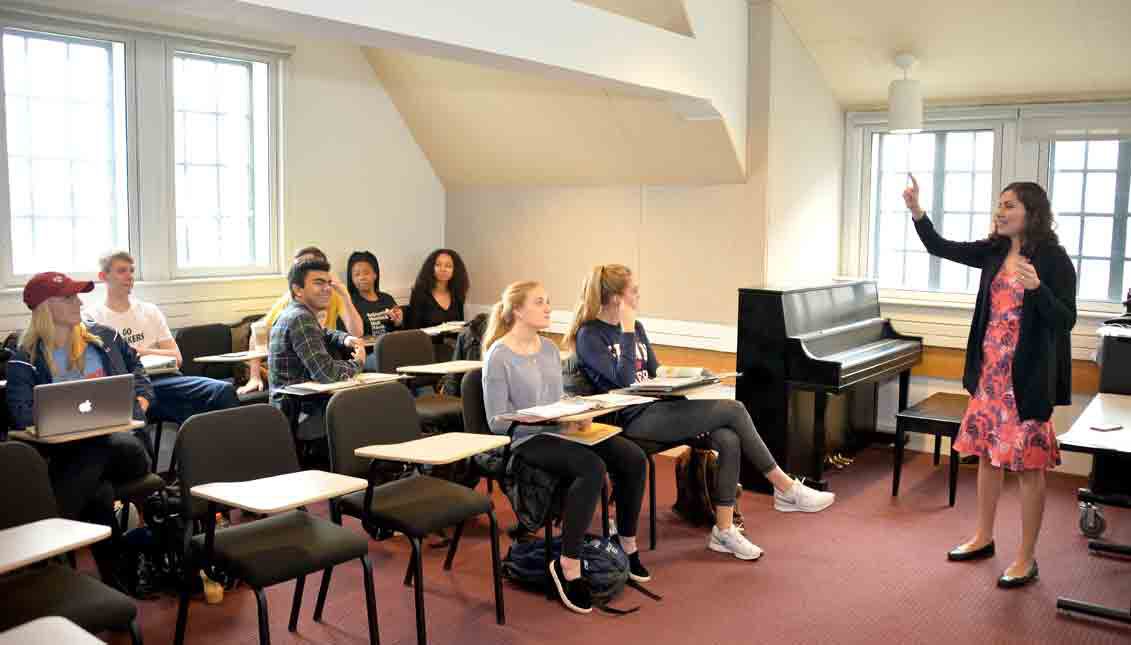
Who wants to study Spanish in Philadelphia?
The Hispanic immigrant community has played a fundamental role in the growth of the city in the last decade. In the streets it is more and more common to hear…
The Hispanic population of the United States remains one of the most important communities in the country’s economy, culture and politics. That weight -of about 57 million people- exerts an important influence in several aspects of the national daily life. For example the use of Spanish as an official second language in many American cities accounts for its political recognition.
It is not an issue without importance. If the Hispanic population in the US is actually bigger than most of the Latin American countries -with the exceptions of Mexico and Brazil-, then it is easy to picture the influence of its language in the American society. That influence can be seen on the different campaigns focused on Hispanics designed by politicians and brands.
That without saying that immigration is still increasing and, at least in Philadelphia, it has played an important role in supporting the region’s growth. According to the US Census Bureau, although there are more people moving out of the city, Philly is still under immigrants radar as a good place to live. In other words, the city’s population has not stop growing in part because of the thriving presence of immigrants, many of them from Latin America.
Around 600,000 Latinos live in the metropolitan area of Philadelphia - 12% of the local population - a figure that has been steadily growing for the past fifteen years. As the Latino community grows, the greater the importance of Spanish on the street and in the labor market. However, is it true that the greater presence of Latinos in recent years has corresponded with a greater interest in studying the language and Hispanic culture in our universities?
"In the last three or four years, the number of students in the Department of Hispanic Studies has fallen sharply, as in most of the Humanities, from History to English Literature," Hiram Aldarondo admits, head of the Spanish and Portuguese Department of Temple University.
"This is mainly due to the constant barrage of news in the media saying that if you study Humanities you will not have work or you will be underpaid," adds this Puerto Rican academic, graduated in Literature from the University of Puerto Rico-Las Piedras and with a doctorate in Romance Languages by the University of Chicago.
Aldarondo took command of the Hispanic Department of Temple University three years ago, just as the University began to notice the shortfall of Spanish students, but took it as a challenge. "In Chicago, I had been teaching business Spanish, it was a special course for Business students. Here in Temple they had already realized that Spanish courses for students of other Majors – aside from Masters - was a very attractive field, but it wasn’t until now that we have started to really empower it", explains the acknowledged Puerto Rican academic.
In the last four years, the Hispanic Department of Temple University has developed a plan to adjust the offer of degrees and academic curriculum to new work needs. "At this moment, learning Spanish has many advantages for students of Business, Public Health, Computing and Communication", areas in which Temple is a reference university, explains Aldarondo. The plan has started to work: "After three years, this is the first course in which we have increased the number of students in Spanish," he explains. Currently, Temple University offers commercial Spanish courses, specific to Business and Business students; Legal Spanish - for those who aspire to work in the judicial system - or specific to work in hospitals and health centers.
The university has also introduced "very successful" exchange programs in Costa Rica and Oviedo, Spain, in order to attract new students and compensate for the shortfall of students in Spanish courses for Master's degrees, which has reached a 30 %.
"The prospect of being a Spanish teacher in a public school has ceased to be attractive, especially in Pennsylvania and New Jersey, where teachers' salaries have been frozen for a long time," Aldarondo explains.
In the United States, Spanish can be learned as a secondary language for two or three years in high school. However, the level acquired is not enough to communicate fluently, not even for the so-called "heritage speakers": Latinos of second or third generation, who speak Spanish at home, but who in many cases don’t know how to read or write, or do so with difficulty.
"In Temple we have specific courses for them. Many understand the language, but it is difficult for them to communicate, because it was embarrassing for them to talk about it in public and parents were fed up with telling them to reply in Spanish", adds Aldarondo.
According to data from the Pew Reserach center, 25% of Philadelphia's Latinos were born outside the United States - while the remaining 76.1% would correspond to second- or third-generation Latinos, heritage speakers, each with its own particular dialect. The majority of the community is Puerto Rican (51%) followed by Mexican (21%) and Dominican (6%).
"We are trying to attract this group to our classrooms," explains Aladarondo, convinced that the heritage speakers have a clear advantage when it comes to finding work in a Justice or Health system where bilingual workers are needed. In the fall, for example, the faculty will offer a specific Spanish course for criminal justice, focused on jobs in the area of police and justice, where the demand for Spanish continues to grow.
However, Latinos represent no more than 25% of Temple Hispanic students. According to Aldarondo, one way to attract Hispanics to the University is to encourage the presence of Latino writers living in the United States, such as Junot Diaz, who writes in Spanglish. "It is a particular literature here, written in two languages and taught in both languages. In addition, it speaks of the cultural confrontation that these students have, so they can identify and be inspired by it," he says.
"In Villanova we have special classes for ‘heritage speakers’. This way, many of them can jump to more advanced classes of Spanish literature or culture and find it easier to follow as a major in Spanish," explains Silvia Nagy-Zekmi, of Romance Languages at Villanova University, a private university on the outskirts of Philadelphia. Villanova has been one of the centers that have noticed the shortfall of Spanish students. Last year, the center decided to suspend the Major in Masters for lack of students, "although it is a temporary measure, until a new curriculum is redesigned," warns Nagy-Zekmi.
"It would be a shame if Spanish programs do not survive, especially when the Hispanic population is expected to represent more than 30% of the American population by 2050. The future jobs will be there in the Hispanic world," adds this teacher ff Hungarian origin.
On the other hand, the Spanish Major remains popular and the numbers have not changed much in the last 5 or 6 years. Villanova has been a reference center in the training of Spanish teachers. "Many of the surrounding schools have our teachers," says Nagy-Zekmi.
One of the department's objectives is to rethink traditional programs and focus on the new needs of the Latino community. For example, several of the Spanish courses involve collaboration with social workshops and cultural organizations in Philadelphia, "although the cultural offer in Spanish in the city is still quite limited," says the professor. "Spanish is still seen as a second-class language and we must strive to overcome these prejudices," she adds.
RELATED CONTENT
Nagy-Zekmi arrived in the United States in 1981 after completing his doctorate in Latin American literature at the University of Budapest. "The United States offered better options to continue with a post-doc," says the Hungarian expert, who after working a long season at SUNY University in Albany, New York, joined Villanova in 2003. In recent years, Nagy -Zekmi explains that her department has noticed a smaller presence of Latin American students. Instead, the presence of Spanish students has grown, those who come to the United States attracted by the possibility of taking a doctorate and collecting a salary at the same time, something increasingly complicated in Europe. This is the case of Mercedes Cebrián, a writer and journalist from Madrid, who came to Philadelphia to finish her doctorate in Hispanic Studies at Penn University between 2013 and 2015.
"Going to the United States, I had the opportunity to get paid for my PhD, while in Spain it would have been impossible. In addition, in the universities inside the US, as well as in the United Kingdom, there is an important Hispanic tradition. In many American universities, exiled Latin American writers and poets, such as Pedro Salinas or Axel González, have been teaching", says Cebrián, author of Malgastar (La Bella Warsaw, 2016), Verano azul: a holiday at the heart of the transition (Alpha Decay 2016) And The Genuine Flavor (Random House Literature, 2014).
Cebrián applied to several universities on the East Coast, and eventually stayed with Penn, "because she liked Philadelphia, was more manageable than New York, better quality of life and well connected," she explains by telephone. What she liked most about her stay at Penn is that in the US "Hispanic studies are a broader concept, going beyond pure Literature and Language. They encompass cinema, theater, humor on television ... they want you to offer new ideas, connect past with the present, classic with current theory", she says.
At Penn, the seminars and courses were in English or Spanish, depending on the profile of the students in class and their language proficiency. "Many of my colleagues were Americans in love with the Hispanic culture", explains Cebrián. In her course she also met Latin American students and teachers, many of them still in Philadelphia. "Some people are afraid to return home if they’re not allowed back in. They are worried about their legal situation after Trump's victory”, she explains.
One of Mercedes' duties as a PhD student at Penn University was teaching Spanish as a second language. And that's how Mercedes met Maria Paredes Fernández, nominated last year "Best Spanish teacher in the USA", by the American Association of Spanish and Portuguese teachers (AATSP). This organization promotes the study and teaching of Spanish and Portuguese and their respective cultural studies with the aim of "contributing to a better understanding between the United States and the Spanish-speaking countries."
"I think that when the came time to receive the award, I appreciated the enthusiasm I put into teaching. For me it is a privilege to expose students to Spanish, I take it very seriously, "explains the teacher via Skype.
Paredes, 33, was born in Philadelphia, from an Ecuadorian mother and Argentine father. She herself is considered a "heritage speaker" and acknowledges that it was not until she entered the university that she became interested in her native culture and language. "I learned Spanish as a child, talking to my parents at home, writing letters to my cousins in Ecuador or when visiting them in the summer. But the truth is that in high school I was embarrassed to talk in Spanish. If someone had told me that I would end up being a Spanish teacher, I would have laughed in his face", says Maria, who began studying visual arts. She didn’t like it, but in college she began to reconnect with her Hispanic roots and became interested in linguistics.
From one day to the next, she dropped out of art and enrolled in Pedagogy at Penn State Univesity. Her first job as a teacher came by chance. "I was working in the cafeteria downtown, when one of my teachers approached me to offer me a job. Too many students had been enrolled and they needed reinforcements. My first students were my age”, she recalls, laughing.
After a season at Penn State, Paredes specialized in teaching Spanish as a second language in Delaware and in 2010 joined Penn's team. In her classes, Maria tries to convey to her students the cultural richness of being bilingual. "I do not want them to think about divisions, I want them to see that we are different, but we have a common goal." Part of the methodology of their classes involves collaborative projects with the Latino community in Philadelphia and attendance to events, after which their students then have to do a written exercise. "In Philadelphia there’s a lack of activities in Spanish, or maybe there are, but they are not well advertised," she says.
Currently, the Spanish department has around 1,500 students, 12% less than in 2009. The majority of students are from other majors: business, nursing, engineering, "people that need Spanish for their work ", explains Paredes.
For the next year, the Department faces a new challenge: Wharton, Penn's business faculty, has announced that it will require its students two language semesters, instead of four, which will lead to a further reduction of Students of Spanish. But Paredes is confident that interest in Spanish will not fall. One of the most successful claims of Spanish studies at Penn are the exchange programs with Buenos Aires, Alicante and Madrid. "I encourage them to travel, to go beyond books," Paredes concludes. After all, Spanish is still the most studied language in the United States, with more than 7.8 million students, counting high school students and university students, according to report of the institute Cervantes of 2013.











LEAVE A COMMENT:
Join the discussion! Leave a comment.